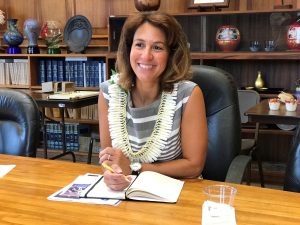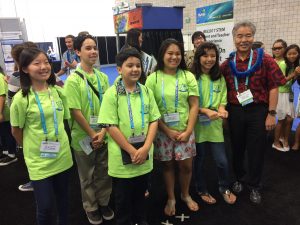Dr. Christina Kishimoto: Hawai‘i’s new superintendent
Posted on Jul 27, 2017 in Capitol Connection, Featured
New DOE superintendent Dr. Christina Kishimoto
It’s late on a Sunday afternoon, and Dr. Christina Kishimoto is driving to a family gathering. But Hawai‘i’s new schools superintendent makes time to talk about her childhood in New York, her passion for public education and the promise she sees for the state’s school system.
Kishimoto has been credited with helping to turn around struggling mainland school districts and improve graduation rates. She served as head of two school districts in Connecticut and Arizona. And with relatives on O‘ahu and the Big Island, she appreciates the unique sense of community that defines Hawai‘i.
“I feel we can set ourselves apart as leaders in education by having students honor their diverse cultures and who they are,” she said. “This core value of appreciating our differences can help us motivate students and design schools that build on the strengths of their communities.”
In fact, she said what excites her most about her new position is the commitment she sees for improving the state’s schools. That’s what she said “charged her up” during the job interview process. “I got a chance to hear from teachers, students, parents, community activists, business leaders and the governor,” she explained. “The more I talked to people, the more I understood their concerns.”
Kishimoto said she was a student in the New York City public school system in the ’70s and ’80s when education was in crisis. She lived in Section 8, low-income housing, the daughter of parents who migrated from Puerto Rico. “I knew there were disparities between schools, depending on your zip code. Sometime around middle school, I developed a drive to want to fix those disparities.”
She went on to earn a doctorate in education administration from Columbia University and has focused on how schools can be designed to help students from any socio-economic background be successful. “School design means assessing student and community needs and figuring out what we need to do differently,” she explained. “The students are still our most important constituents.”
Top areas of focus for Kishimoto include:
- School design – Helping people understand how the school design process can improve student learning — from creating a positive school culture to structuring a classroom for student success.
• Student voice – Developing a positive process that incorporates more student feedback to improve what works in the classroom.
• Teacher collaboration – Providing more opportunities for teachers to work together to share ideas and determine how resources can best be used to shape learning.
Kishimoto described herself as a strong believer in student voice and supporting the role of teachers in improving education. “We know the central administration can provide support and policy parameters, but it’s what teachers do in the classroom that make the difference. How do we make principals and teachers comfortable to take some risks and design around a school’s needs without worrying if they’re going to get in trouble with the central office? How do we make it okay for students to tell us what’s working in an assignment and what could be better, and do it in a respectful, helpful way? And how do we make the community feel a part of the process?”
As for the new Every Student Succeeds Act (ESSA) law, the governor’s Blueprint and the DOE/BOE strategic plan, she said she hopes to clarify how they all work together. “ESSA is a federally required plan to make sure there is equitable funding based on student needs. The Blueprint provides a great vision for the future in flexibility and innovation, and the strategic plan lays out a shorter time frame of three to five years with specific goals,” she explained. “All are well-developed; what we need now is an implementation plan to decide what we should focus on and how this affects each school.”
Kishimoto said although she has relatives in Hawai‘i, she wants people to get to know her and what she can bring to the state’s school system. “I have a lot of diversity in my background, and I see the schools as a reflection of our democracy.”
She admits those who know her say, “’Wow, you’re pretty passionate about public education.’ Many of our most successful citizens are the products of our public schools. We need to be proud of that.”
